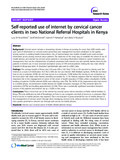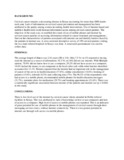| dc.contributor.author | Kivuti-Bitok, Lucy W | |
| dc.contributor.author | McDonnell, Geoff | |
| dc.contributor.author | Pokhariyal, Ganesh P | |
| dc.contributor.author | Roudsari, Abdul V | |
| dc.date.accessioned | 2013-03-19T15:39:31Z | |
| dc.date.available | 2013-03-19T15:39:31Z | |
| dc.date.issued | 2012-10-09 | |
| dc.identifier.citation | BMC Research Notes. 2012 Oct 09;5(1):559 | |
| dc.identifier.uri | http://dx.doi.org/10.1186/1756-0500-5-559 | |
| dc.identifier.uri | http://erepository.uonbi.ac.ke:8080/xmlui/handle/123456789/14674 | |
| dc.identifier.uri | http://www.ncbi.nlm.nih.gov/pubmed/23046538 | |
| dc.description.abstract | Abstract
Background
Cervical cancer remains a devastating disease in Kenya accounting for more than 2000 deaths each year. Lack of information on cervical cancer prevention and management has been attributed to the apathy among women in seeking health interventions. Use of internet-based and mobile e-health tools could increase information access among cervical cancer patients. The objective of the study was; to establish the extent of use of mobile phones and internet by cervical cancer patients in accessing information related to cancer treatment and management.; find out the characteristics of patients associated with internet use and identify barriers faced by the patients in internet use. A cross sectional descriptive survey of 199 cervical patients visiting the two main referral hospitals in Kenya was done. A structured questionnaire was used to collect data.
Findings
The average length of illness was 2.43 years (SD ± 3.0). Only 7.5 %( n=15) reported to having used the internet as a source of information. 92.5 %( n=184) did not use internet. With Multiple options, 70.9% did not know how to use a computer, 29.2% did not have access to a computer, 14.6% lacked the money to use computers at the local cyber cafe while other barriers identified accounted for 11.1%. Patients reported that the internet had an important role in the management of cancer of the cervix in health education (17.6%), online consultation (14.6%), booking of patients (13.6%), referrals (8.5%) and collecting data (7%). The 96.5% of the respondents who had access to a mobile phone, recommended mobile phones for health education messages (31.7%), reminder alerts for medication (29.7%) and booking appointments (21.6%). There was a statistically significant association between income of the patients and internet use (p = 0.026) in this study.
Conclusions
There is low level use of the internet by cervical cancer clients attended in Public referral facilities in Kenya. This was attributed to; lack of knowledge on how to use computers and lack of access to a computer. High level of access to mobile phones was reported. This is an indicator of great potential for use of mobile phones in the management of cervical cancer through short messaging services (sms), without internet connectivity. There is even greater potential to internet use through web access via mobile phones. | |
| dc.relation.uri | http://www.ncbi.nlm.nih.gov/pubmed/23046538 | |
| dc.title | Self-reported use of internet by cervical cancer clients in two National Referral Hospitals in Kenya | |
| dc.date.updated | 2013-03-19T15:39:31Z | |
| dc.description.version | Peer Reviewed | |
| dc.language.rfc3066 | en | |
| dc.rights.holder | Lucy W Kivuti-Bitok et al.; licensee BioMed Central Ltd. | |


